| |
Glossary of Coral Reef Terminology - O
Oak Foundation - a group of charitable and philanthropic organizations established in various countries. The Oak Foundation commits its resources to address issues of global social and environmental concern, particularly those that have a major impact on the lives of the disadvantaged. It’s marine environment program focuses on three main areas: the Mesoamerican reef ecosystem; European marine conservation; and Bering Sea and North Pacific conservation |
OBIS (Ocean Biogeographic Information System) - the marine component of the Global Biodiversity Information Facility. It links marine databases around the world to provide an internet accessible, dynamic interface for comparing species level, geo-referenced biodiversity data in relation to ocean habitats. All Census of Marine Life (CoML) field project data will be managed in and accessible through OBIS (www.iobis.org) |
obligate mutualism - a mutualistic relationship where one species cannot survive without the presence of the other |
obligatory - obligate or required. For example, an obligatory cleaner fish relies entirely on this feeding mode to obtain nutrients; opposite of facultative |
oblong - elongated (stretched) from a square or circular shape |
observational learning - a learning process where an animal learns by copying the behavior of other animals |
observing system - a collection of one or more sensing elements (human and/or instrument) that reside on fixed or mobile platforms; directly or indirectly measuring environmental parameters on a defined basis meeting data user objectives |
obtuse - blunt or rounded at the end |
ocean - the salt water surrounding the great land masses, and divided by the land masses into several distinct portions, each of which is called an ocean; the entire body of salt water that covers more than 70 percent of the earth's surface. There are five oceans: the Pacific, Atlantic, Indian, Arctic and Antarctic (Southern Ocean) |
ocean acidification - the decrease in the ocean's pH and the resulting increase in acidity as the oceans absorb carbon dioxide released into the atmosphere by human activities |
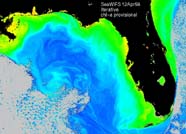
SeaWiFS (Sea-viewing Wide Field-of-view Sensor) ocean color image of chlorophyll-a in the Gulf of Mexico.
|
ocean color - a term that refers to the spectral dependence of the radiance leaving a water body |
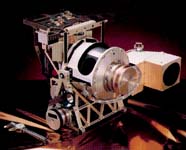
This SeaWiFS (Sea-viewing Wide Field-of-view Sensor) is an ocean color sensor.
|
ocean color sensor - an instrument for the remote sensing of ocean color, usually from aircraft or satellite |
ocean iron fertilization (OIF) - the intentional introduction of iron to the upper ocean in order to increase the growth of phytoplankton blooms and to sequester carbon dioxide from the atmosphere . It promotes the growth of phytoplankton blooms by physically distributing microscopic iron particles in otherwise nutrient-rich, but iron-deficient ocean waters |
Ocean.US - Ocean.US, the National Office for Integrated and Sustained Ocean Observations, was established by the Congressionally-created National Oceanographic Partnership Program (NOPP). Since its establishment on 2000, Ocean.US has catalyzed the coordinated development of an Integrated Ocean Observing System (IOOS), the U.S. contribution to a Global Ocean Observing System (GOOS) and to the Global Earth Observation System of Systems (GEOSS). Ocean.US is a federal interagency office supported by ten agencies |
Oceania - a region of the world that usually includes Australia, New Zealand, and Pacific Ocean islands, such as Micronesia, Melanesia and Polynesia |
oceanic - associated with sea-water environment seaward of the shelf-slope break |
oceanic crust - that part of the Earth's crust underlying the ocean basins. It is composed of basalt and has a thickness of about 5 km |
oceanic island - an island in the ocean formed by breaking away from a continental landmass, volcanic action, coral formation, or a combination of sources |
oceanic reef - a reef that develops adjacent to deeper waters, often in association with oceanic islands |
oceanic zone - the pelagic marine environment beyond the shelf-slope break with a depth greater than 200 m |
oceanodromous - used to describe organisms that migrate only within the ocean, usually from spawning grounds to feeding grounds |
oceanography - the study of the earth's oceans and their interlinked ecosystems and chemical and physical processes. There are five major divisions within the science: physical oceanography, chemical oceanography, biological oceanography, geological oceanography, and meteorological oceanography |
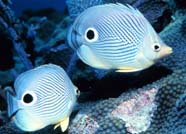
These butterflyfish have a prominent ocellus (pl. ocelli), which may serve to deflect predator attacks from the head region of the fish.
|
ocellus - an eye-like spot, usually surrounded with a ring of a lighter color, e.g. the ocellus toward the caudal peduncle of some butterflyfish. It may function to deflect attacks to the eyes in agonistic encounters.Ocelli are also present in other animal groups, especially insects |
ochre - yellowish or yellow-brown color |
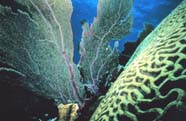
An octocorallian (sea fan) with brain coral (sceractinian) in the foreground.
|
Octocorallia - a subclass of the Anthozoa that contains the sea pens, sea pansies, sea fans, whip corals, and pipe corals. Octocorals always possess 8 tentacles and 8 complete septa (hard corals and anemones possess 12 or more tentacles and septa). They are colonial cnidarians whose polyps are connected by a tissue mass called the coenenchyme. This tissue connects the gastrovascular (digestive) cavities of all the polyps in the colony |
octopus - in scuba, a backup second stage regulator connected to the first stage, intended for the benefit of other scuba divers in case their air supply should fail. It is the alternate air source that forms the basis for the "buddy" system |
ocular - pertains to the eye |

The Oculina Banks are deep water coral reefs occurring along the shelf edge off the central east coast of Florida. The Oculina varicosa habitat hosts a diverse array of macroinvertebrates and fishes. The habitat also comprises significant spawning grounds for economically important species of reef fishes.
|
Oculina Banks - a series of deepwater coral pinnacles and ridges, 15 to 30 miles off the east coast of Florida, extending from Ft. Pierce to Cape Canaveral. Formed by a single species of coral, the Ivory tree Coral, Oculina varicosa, they form pinnacles of up to 100 feet tall, growing below the Gulf Stream at depths of approximately 70 to 100 meters. This is a slow-growing, branching coral often associated with high biodiversity because they provide ideal habitats and spawning sites for numerous species of fishes and invertebrates |
Oculina varicosa - an important deep water coral reef-building species that forms thickets of large branched colonies along the eastern Florida shelf. O.varicosa is restricted to the western Atlantic, including the Caribbean and Gulf of Mexico, Florida to North Carolina and Bermuda. The deep-water Oculina reefs, however, are only known off the east coast of central Florida at depths of 70-100 m |
odontophore - a tooth-bearing structure found in most mollusks, except bivalves. It consists of several muscles and a cartilage which support the radula and radula sac; the term is also applied to the radula alone |
off-reef - a synonym of reef slope |
Office of Insular Affairs (OIA) - The Office of Insular Affairs (OIA) carries out the Secretary of the Interior s responsibilities for the insular affairs. OIA coordinates Federal policy in the territories of American Samoa, Guam, the U.S. Virgin Islands, and the Commonwealth of the Northern Mariana Islands. With the majority of U.S. coral reefs located in the insular areas, OIA plays an important role in improving the management and protection of the Nations coral reefs. OIA also provides technical and financial assistance to the Federated States of Micronesia, the Republic of the Marshall Islands, and the Republic of Palau which share financial, diplomatic and military ties with the United States through a special relationship known as the Compact of Free Association. The freely associated states have some of the richest coral reef resources in the world and some of the oldest and most effective traditional management systems |
official index - in taxonomy, a list of names or works suppressed or declared invalid by action of the International Commission on Zoological Nomenclature |
official list - in taxonomy, a list of names or works which have been conserved or declared valid by action of the International Commission on Zoological Nomenclature |
offshore current - any current flowing away from shore |
offshore wind - a wind blowing seaward from the land in the coastal area. |
olfaction - the sense of smell |
olfactory - pertaining to the sense of smell (olfaction) |
oligo - a prefix meaning "few" |
oligomer - a molecule of intermediate relative molecular mass, the structure of which essentially comprises a small plurality of units derived, actually or conceptually, from molecules of lower relative molecular mass; a polymer that consists of two, three, or four monomers |
oligonucleotide - a short sequence (usually 2-50 bases) of DNA. Oligonucleotides of up to 30 bases are routinely synthesized for use as PCR primers or as probes for their sequence compliments in a complex mixture of DNA |
oligopeptide - a peptide which consists of a small number of amino acids linked together, as opposed to a polypeptide |
oligosaccharide - a carbohydrate which consists of three to ten monosaccharide molecules joined by glycosidic linkages |
oligotrophic - refers to water bodies with low concentrations of nutrients |
omega animal - in animal behavior, the animal which has the lowest social rank in its linear hierarchical group |
omega-conotoxin MVIIA - a marine pharmaceutical extracted from the cone snail, Conus magnus. It is a potent pain-killer (analgesic) which acts by interfering with calcium ion flux, thereby reducing the release of neurotransmitters |
omegoid - horse shoe-shaped |
omnivore - an organism whose diet consists of a wide variety of foodstuffs, including plants and animals |
oncogene - a gene thought to be capable of causing cancer |
oncology - the science dealing with the physical, chemical and biological properties and features of cancer, including the causes and progression of the disease |
one-gene--one-polypeptide hypothesis - the concept that one gene in DNA codes for a sequence of amino acids in a specific polypeptide |
online - a general term for when one computer is interacting directly with another computer |
Online Positioning User Service (OPUS) - OPUS provides Global Positioning System (GPS) users, such as scientists, engineers, and professional surveyors, the ability to obtain highly accurate positioning coordinates for the purposes of transportation, construction, navigation, surveying, and other activities. OPUS allows GPS users to submit their GPS data files via the Internet to NOAA, where the data are processed to determine a position using NOAA’s computers, software and national coordinate system. OPUS is managed and operated by NOAA's National Geodetic Survey (NGS), which defines and manages a national coordinate system. This network, the National Spatial Reference System (NSRS), provides the foundation for transportation and communication; mapping and charting; and a multitude of scientific and engineering applications |
onomatophore - in taxonomy, a specimen which acts as the name bearer; a nomenclatural type (holotype, syntype, lectotype, neotype) |
onshore - a direction landward from the sea |
onshore wind - a wind blowing landward from the sea in the coastal area |
ontogenesis - the entire development of an individual organism from fertilization to completion of its life history |
ontogeny - the development, growth, and maturation of an individual |
oocyte - a female gametocyte that develops into an ovum after two meiotic divisions; the female reproductive cell, also called an egg or ovum |
ooecium - a brood chamber for developing embryos in the Ectoprocta (bryozoans); one of the special zooids of ectoprocts destined to receive and develop ova; an ovicell. |
oogamous - characterized by reproducing by the fusion of small motile male gametes and large nonmotile female gametes |
oogamy - the union of a large nonmotile egg with a small motile or nonmotile male sperm cell |
oogenesis - the process of ovum (egg) development in female animals, in which the diploid number of chromosomes is reduced by half to the haploid number in the ovum |
oolitic limestone - rock composed primarily of petrified corals or the skeletons of other calcareous animals |
open circuit scuba - a diving apparatus in which exhaled air is expelled into the water as bubbles; no part is rebreathed by the diver. It is most commonly used in recreational scuba diving |
open circulatory system - a circulatory system, characteristic of some invertebrates, e.g., arthropods, in which blood flows through an interconnected system of open sinuses rather than blood vessels. The tissues and cells are directly bathed by the blood for gaseous exchange and nutrient uptake. The circulatory fluid is called the hemolymph |
open coast - an unenclosed and exposed coastal margin |
open sea - that part of the ocean that extends outward from the continental shelf |
open system - a system that exchanges energy and matter with its environment |
OPeNDAP (Open-source Project for a Network Data Access Protocol) - OPeNDAP is a framework that simplifies all aspects of scientific data networking, allowing simple access to remote data. OPeNDAP provides software which makes local data accessible to remote locations regardless of local storage format by using OPeNDAP servers. OPeNDAP also provides tools for transforming existing applications into OPeNDAP clients (i.e., enabling them to remotely access OPeNDAP served data); a protocol for requesting and transporting data across the web. The current OPeNDAP Data Access Protocol (DAP) uses HTTP to frame the requests and responses; a community of users working together to use, improve, and extend the OPeNDAP protocol and software; Although OPeNDAP was originally designed and developed by oceanographers and computer scientists for oceanographic data, there is nothing in the design of OPeNDAP that constrains its use to oceanography. It has been adopted by the High Altitude Observatory community and is being considered by segments of the meteorological and space science communities; previously known as "DODS" |
operant conditioning - a learning process where an animal learns by connecting its own behavior with a response from its environment |
operational taxonomic unit (OTU) - a terminal taxon; a group of organisms used in a taxonomic study without designation of taxonomic rank |
operator gene - a region of the chromosome, adjacent to the operon, where a repressor protein binds to prevent transcription of the operon |
opercular spine - in fishes, a spine projecting from the operculum (gill cover) |
operculate - having an operculum |

A ventral view of the gill chamber and opercular chamber of a fish. Note the gill (branchial) arches, each with a large number of gill filaments. (Photo: University of California at Davis)
|
operculum - a lid or flap covering an aperture, such as the gill cover in most bony fishes; the gill cover; also the horny lid closing the aperture of various species of mollusks |
operon - a sequence of genes responsible for synthesizing the enzymes needed for biosynthesis of a molecule. An operon is controlled by an operator gene and a repressor gene |
ophiopluteus larva - larva of a brittle star (phylum Echinodermata) |
opisthobranch - a marine gastropod, many of which have lost or reduced their shell, mantle and gills |
opisthosoma - a short, posterior multi-segmented region of a vestimentiferan polychaete tube worm. The anterior segments of the opisthosoma have rows of hook-like structures that act as anchors for the worm to retract into the tube |
opportunistic feeder - a species adapted for utilizing variable, unpredictable or transient environments to obtain food |
optical oceanography - the subdiscipline of oceanography concerned with the propagation and interaction of radiation, typically at wavelengths between about 350 and 750 nm, with seawater |
optimum - a state that is the best fit for the current situation. All minor changes make the situation worse; in biology, it is the level of some environmental factor, within a species' or population's tolerance range, at which the species or population can function most efficiently or with the greatest positive effect to its physiological or reproductive fitness |
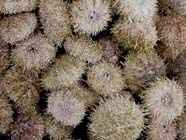
The oral surface of some sea urchins. The central opening is the mouth.
|
oral - pertaining to the mouth |
oral cavity - the cavity within the mouth |
oral disc - the area around the mouth of an anthozoan polyp that bears from eight to several hundred tentacles |
oral pinnule - arms of feather stars (Echinodermata-Crinoidea) bear numerous pinnately arranged branches called "pinnules ." Those pinnules closest to the disk are the proximal, or oral pinnules. They are larger than other types of pinnules and respond to mechanical stimulation. They guard the disk and can arch over it and almost completely cover it. They do not have ambulacra or tube feet. A few pairs of oral pinnules are at the base of each arm. Moving distally from the disc are the genital pinnules which contain the gonads, followed by the the distal pinnules which occupy the outer end of the arm. They are the major feeding structures and always have ambulacra and tube feet |
orbit - a bony or cartilaginous eye socket |
order - a taxonomic group containing one or more families |
organ - a collection of tissues which performs a particular function or set of functions in an animal's body. Organs are composed of tissues, and may be organized into larger organ systems |
organ system - collection of organs which have related roles in an organism's functioning. The nervous system, circulatory system, and muscle system are all organ systems |
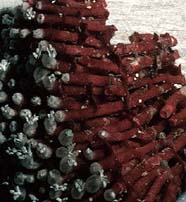
The organ-pipe coral, a reef-building octocoral. (Photo: A. Bruckner, NOAA)
|
organ-pipe coral - the organ-pipe coral, Tubipora musica, is a reef-building (hermatypic) octocoral |
organelle - a structurally discrete component of a cell, e.g., the nucleus or a mitochondrion |
organic - refers to those substances produced by the metabolism of a living organism, especially carbon-containing compounds |
organic act - the body of laws that the United Congress has enacted for the government of a United States insular area; it usually includes a bill of rights and the establishment and conditions of the insular area's tripartite government |
organic enrichment - the addition of nutrients from organic matter |
organic molecule - a molecule that contains one or more carbon atoms |
organically polluted - made unfit for living organisms by excess addition of organic matter |
organism - any form of unicellular or multicellular life; a living thing that has (or can develop) the ability to act or function independently |
organized territory - a United States insular area for which the United States Congress has enacted an organic act |
organogenesis - the process of formation of specific organs in a plant or animal involving morphogenesis and differentiation |
organophosphate - organophosphate compounds are a diverse group of chemicals used in both domestic and industrial settings. Examples include insecticides, nerve gases, ophthalmic agents, and antihelmintics. Organophosphate pollution may adversely effect coral health |
orientation - the way an organism positions itself in relation to environmental cues; the ability of an animal to be aware of its environment and its position within that environment with reference to time and space |
original description - in taxonomy, the description of a taxonomic group when first established |
original diagnosis - in taxonomy, a formal statement of characters which distinguish a taxon from other similar or closely related taxa, published at the time of proposal of a new taxonomic name |
original spelling - in taxonomy, the spelling of an available name when first published. The original spelling of a name is to be kept as the "correct original spelling" unless it does not meet the requirements of the International Code of Zoological Nomenclature. An incorrect original spelling is an original spelling that is incorrect. Multiple original spellings are two or more different original spellings for the same name |
ornamental - a non-food species that is produced and maintained solely for exhibit purposes in home or public aquaria, or in ornamental garden ponds |
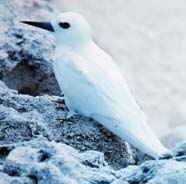
A white tern from Laysan Island, Hawaiian Archipelago. (Photo: NOAA)
|
ornithology - the scientific study of birds |
oroidin - a cytotoxic family of alkaloids isolated from sponges which possesses anti-tumor properties |
orphan receptor - a potential receptor gene identified on the basis of nucleotide sequence similarities with known steroid hormone receptors |
ortholog - a gene found in different species that evolved from a common ancestral gene by speciation. Normally, orthologs retain the same function in the course of evolution |
orthologous genes - genes that have evolved directly from an ancestral gene. This is in contrast to paralogous genes; two genes are to be orthologous if they diverged after a speciation event, i.e., if a gene exists in a species, and that species diverges into two species, then the copies of this gene in the resulting species are orthologous |
orthology - homology (similarity of features based on common descent) that arises via speciation |
oscillation - any steady back and forth movements |
oscillator - the internal biological clock mechanism that produces a measurable biological rhythm in an organism |
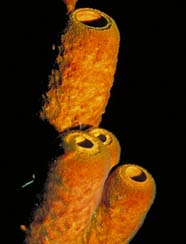
Distinct osculi of some Caribbean sponges. (Photo: Copyright Digital Stock Corp.)
|
osculum - a large opening through which water flows out of a sponge. Sponges may have more than one osculum |
osmole (Osm) - a unit of osmotic pressure used in cell biology and physical chemistry. One osmole is the osmotic pressure of a one molar solution (a solution with a concentration of one mole per liter of solvent) of a substance that does not dissociate, such as glucose, in water. In practice, most measurements are in milliosmoles (mOsm) |
osmoregulation - the process of controlling the amount of water in tissues and cells |
osmosis - the passage of water through a semipermeable membrane from a solution with a lower concentration of solute to one with a higher concentration of solute |
osmotic pressure - the pressure that is needed to counteract the osmotic passage of water molecules across a semipermeable membrane into the more concentrated solute |
osmotroph - an organism that obtains nutrients through the active uptake of soluble materials across the cell membrane |
ossicle - one of numerous small calcareous structures that form the exoskeleton of certain echinoderms. Their size,shape and location are highly variable, and they may be movable or fixed in position. They may appear as thin fused plates. In brittle stars they form "vertebrae" in the arms, which with together with their attached muscles, gives the brittle star its serpentine ophiuroid motion. Sea cucumbers hve microscopic ossicles embedded in their dermis. The small, sound transmitting bones in the vertebrate middle ear are also called 'ossicles' |
ossified - made or converted into bone |
ostium - in sponges, a microscopic pore through which water enters the sponge body |
ostracitoxin - a toxin, discharged with mucus into the water, by trunkfishes of the genus Ostracion when they are stressed |

A section of an otolith from an early life stage fish. Growth rings are counted and a daily age is determined, this information can be applied to understanding the effects of changes in the environment on growth and survival. (Photo: NOAA)
|
otolith - a calcareous structure of the inner ear of some animals, such as fishes, that functions in the detection of changes in gravitational forces relative to orientation. Otoliths are used to determine the age of fishes by counting the number of annual rings deposited |
outbreak - the sudden appearance of a disease in a specific geographic area or population |
outbreak - a sudden appearance or increase in something, such as an outbreak of a particular disease in a coral community |
outcrop - an exposure of bedrock that can be seen on the surface, i.e., that is not covered by soil or water |
outer slope - a synonym of reef slope. It is sometimes used to represent the lower reef slope |
outfall - the place where a sewer, drain, or stream discharges |
outlying area - the term 'outlying area' refers to the United States Virgin Islands, Guam, American Samoa, and the Commonwealth of the Northern Mariana Islands. It also may include the freely associated states of the Republic of the Marshall Islands, the Federated States of Micronesia, and the Republic of Palau |
outrigger - a floatation device attached to one or both sides of the hull of a boat to help prevent a capsize |
overexploitation - the removal of individuals or biomass from a population at a rate greater than the population is able to compensate for with its own recruitment |
overfishing - a level of fishing effort or fishing mortality such that a reduction of this level would, in the medium term, lead to an increase in the total catch; harvesting at a rate greater than the population can sustain |
overwash - a deposit of marine-derived sediments landward of a barrier system, often formed during large storms; transport of sediment landward of the active beach by coastal flooding during a tsunami, hurricane, or other event with extreme wave action |
ovicell - the brood chamber of a bryozoan (Ectoprocta), usually located at the distal end of the maternal zooid. Embryos are brooded until they develop into non-feeding larvae, which swim briefly, then settle and metamorphose to found a new colony |
ovigerous - carrying eggs or modified for carrying eggs |
oviparity - the reproductive mode where eggs are released from the body and later hatch |

A marine turtle depositiong eggs (oviposition) on a tropical beach. (Photo: Seaturtle Preservation Society of Brevard County, FL)
|
oviposition - the process of depositing eggs |
ovoviviparity - the reproductive mode where the eggs hatch and develop in the female's reproductive tract (or a specialized pouch in the males of some species), are not nourished in any way by the female, and are free-swimming when released from the parent |
ovulation - the release of an egg from the ovary |
ovum - the mature female germ cell (egg; female gamete) |
oxidant - an oxidizing agent |
oxidation - the combination of a substance with oxygen. Oxidation can also describe a type of reaction in which the atoms in an element lose electrons and the valence is correspondingly increased |
oxidative stress - a process whereby the metabolic balance of a cell is disrupted by exposure to environmental substances, resulting in the accumulation of free radicals, which can damage components of cells' membranes, proteins or genetic material by "oxidizing" them |
oxygen isotope ratio (18O) - an expression for the ratio of the 18O to 16O atoms in a sample relative to a standard, defined as: δ18O = (18O/16O sample - 18O/18O standard)/ 18O/16O standard |
oxygen isotopes - oxygen atoms that have the same atomic number (protons) but different mass numbers (and different numbers of neutrons). The two stable isotopes of oxygen are 16O and 18O |
oyster reef - a dense, highly structured community of individual oysters growing on the shells of dead oysters |
ozone - a gaseous molecule that contains three oxygen atoms (O3), instead of the usual two (O2). Ozone can exist either high in the atmosphere (stratosphere), where it shields the Earth against harmful ultraviolet rays from the sun, or close to the ground (troposhere), where it is the main component of smog. Ground-level ozone is a product of reactions involving hydrocarbons and nitrogen oxides in the presence of sunlight. Ozone is a potent irritant that causes lung damage and a variety of respiratory problems |
ozone shield - the ozone (O3) layer in the stratosphere that gives protection to the Earth's surface because of intense absorption of harmful solar ultraviolet radiation by the gas |
|
|
|
|

